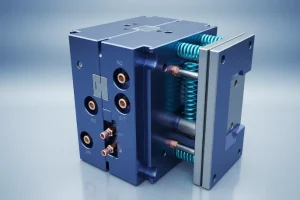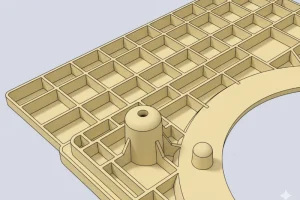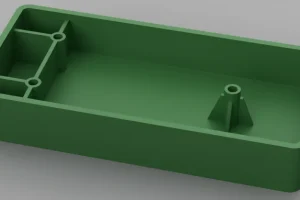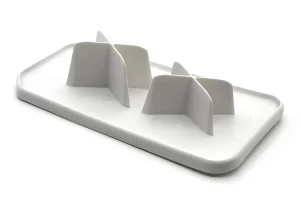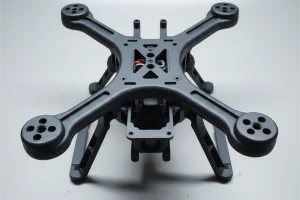Introduction: Injection Molding, also known as plastic injection molding, is a common method for manufacturing plastic products. Injection molding is a manufacturing process that allows parts to be produced in large quantities.

It works by injecting molten material into a mold . How are injection molds made? This article discusses this issue.
Overview of Injection Molds and Injection Molding
What are the Definitions and Theorems of Injection Molds and Injection Molding?
Injection mold is a tool for producing plastic products; it is also a tool that gives plastic products complete structure and precise dimensions.The processing equipment corresponding to the injection mold is an plastic molding machine.

The plastic is first heated and melted in the heating barrel at the bottom of the injection molding machine. Then, driven by the screw or plunger of the injection molding machine, it enters the mold cavity through the nozzle of the injection molding machine and the pouring system of the mold. The plastic is cooled and hardened to form, and the product is obtained by demoulding.
Injection molding process and plastic injection molding process are the same process technology. Namely, plastic injection molding work Similar to Plastic Injection Molding Process, injection molding is a process in which molten thermoplastic plastic resin is sprayed into a closed mold cavity through a nozzle under many parameters such as pressure, temperature, speed and time. After cooling and hardening, a product of the desired shape is obtained.

The basic principle is to add a certain amount of plastic particles (or powder) into the injection molding machine heating cylinder and push it into the mold cavity using a conical screw.
The plastic melts into a melted plastic under high temperature and high pressure.and become molten plastic After a certain amount of compression, it passes through the throat. It enters the mold cavity and then cools and hardens into the desired product.

What is the Relationship Between Injection Molds and Injection Molding?
Injection mold is one type of plastic injection mold,A mold is a tool used to shape objects. This tool is composed of various parts, and different molds are composed of different parts. Injection molding is a way of molding plastic products.

Plastic injection molds include injection molding, blow molding (plastic bottles), and extrusion molding (pipe fittings)The action of closing the two mold halves is called mold closing, and the action of separating the two half-molds is called mold opening.
Different molding methods have their own molding molds. In the injection molding process, there are corresponding injection molds.
Design Process
What Related Software is Needed for the Design of Injection Molds?
CAD: Computer Aided Design refers to the use of computers and graphics equipment to help designers carry out design work. It is usually based on an interactive computer system with graphics functions. CAD mainly includes interactive technology, graphics transformation technology, surface modeling and solid modeling technology, etc.

First of all, CAD is a visual drawing software. Many commands and operations can be achieved through menu options and tool buttons. It also has rich drawing and drawing auxiliary functions, such as entity drawing, key point editing, object capturing, annotation, bird’s-eye view display control, etc.
Its toolbar, menu design, dialog box, graphics open preview, information exchange, text editing, image The output preview of processing and graphics brings great convenience to users’ drawing.

Cimatron: It is a very powerful flow chart production tool for production enterprises. It can improve the efficiency of enterprise mold and parts design, accelerate the entire design process of injection molds, and effectively reduce production costs, allowing the enterprise workshop to release powerful productivity improvements. Enterprise economic benefits.
UG NX: It is a 3D software that can draw product drawings and mold drawings. Using NX modeling, industrial designers can quickly establish and improve complex product shapes, and use advanced rendering and visualization tools to maximize satisfaction. Aesthetic requirements for design concepts.

With high-performance mechanical design and drafting capabilities, NX provides manufacturing design with high performance and flexibility to meet the needs of customers designing products of any complexity.
NX goes beyond general-purpose design tools with a professional piping and wiring design system, sheet metal modules, specialized plastic part design modules and other specialized applications required for industry design.

Mold Wizard (Injection Mold Wizard): MoldWizard is developed based on NX and is a professional module for injection mold design. The module is equipped with commonly used mold base libraries and standard parts.
Users can easily adjust it according to their own needs, and also Self-development of standard parts can be carried out, which greatly improves the efficiency of mold design.
The Mold Wizard (Injection Mold Wizard) module provides the entire mold design process, including product loading, layout, parting, mold base loading, pouring system, cooling system, and engineering drawings

The entire design process is very intuitive and fast, and its application design allows ordinary designers to complete some medium and difficult mold designs
What Factors Should be Considered When Designing Efficient Molds?
The Main Mold Surface Strength of the Mold: mold surface wear resistance, surface wear resistance, lifting efficiency and at the same time mold quality.

About surface reinforcement, different uses of the base and model selection, different reinforcement methods.
Variation Form of the Notes: With high tones, the structure becomes more flexible and the variation form decreases. Thorough avoidance of surface structure, rational arrangement method and uneven structure. Rationally designed strengthening muscles.
Plastic Precision: Due to the unevenness and uncertainty of plastic parts processing, the plastic precision is low.

Mechanical dimensions and tolerances are not possible in simple cases and tolerances are required for standard installations. Published by Gakuniyasha in 1993, GB/T14486-93 “Zero Scale Tolerance of Process Plastics and Imitation Plastics”.
Designers can specify specific requirements for plastic raw materials for installation and set specific dimensions and tolerances.

At the same time, it is necessary to understand the overall performance of the equipment and the design accuracy of the product, and determine the corresponding design tolerance accuracy.
Choose the Right Material for the Mold
What are the Mold Materials?
Metal materials are commonly used materials for manufacturing injection molds. Common metal materials include steel, aluminum alloy, copper alloy, etc. Among them, steel material is the most common injection mold material.

Because of its high hardness, high strength, high wear resistance and good processing performance, it can meet the requirements of most injection molds.
Aluminum alloy materials have lower density, higher thermal conductivity and better processing performance, and are suitable for the production of small injection molds; copper alloy materials have high thermal conductivity and good corrosion resistance, and are suitable for the production of high-demand molds. Injection mold.

How to Choose the Appropriate Mold Material?
Mold material selection is a very important link in the entire mold making process. Mold material selection needs to meet three principles, namely: the mold meets working condition requirements such as wear resistance, strength and toughness; the mold meets process performance requirements; and the mold meets economic requirements.
Manufacturing Process
Mechanical Processing
CNC Machining: The UG NX machining basic module provides a basic framework to connect all UG machining modules. It provides a same, user-friendly graphical window environment for all UG NX machining modules.

Users can graphically observe the tool path along the path. Movement conditions and can be modified graphically: such as extending, shortening or modifying the tool path, etc.
This module also provides general point processing programming functions, which can be used for drilling, tapping, boring and other processing programming.
The interactive interface of this module can be flexibly modified and tailored according to user needs, and can define a standardized tool library and a processing process parameter template library to standardize common parameters for initial machining, semi-finishing, finishing and other operations to reduce training time.

And optimize the processing technology. All modules of UG software can directly generate processing programs on the solid model and remain fully relevant to the solid model.
The machining post-processing module of UG NX allows users to easily establish their own machining post-processing program. This module is suitable for mainstream CNC machine tools and machining centers in the world. The machining post-processing module of UG NX allows users to easily establish their own machining post-processing program. This module is suitable for mainstream CNC machine tools and machining centers in the world. The module has proven suitable for 2 to 5 or more axis milling, 2 to 4 axis turning, and wire EDM.
EDM (Electrical Discharge Machining)
EDM: A continuously moving thin metal wire (called an electrode wire) is used to perform a pulsed spark discharge on the workpiece to remove metal.

It is mainly used for processing various complex and precise workpieces, such as punches, concave molds, concave and convex molds, and unloading plates. Manufacture of punching dies, forming tools, templates, and metal electrodes for electrical discharge machining. Various fine hole grooves, thin slits, arbitrary curves, etc.
It has excellent advantages such as small machining allowance, high machining accuracy, short production cycle, and low manufacturing cost, and is widely used in production sites.

Cutting machine tools account for more than 61% of the total number of electrical discharge machining machine tools in Japan and overseas. The maximum accuracy of electrical discharge machining is ±0.005mm, and the surface roughness reaches mirror surface.
Electrical discharge machining is widely used in the machining field, especially precision machining. The ejection station can be the cavity of various large plastic molds, or it can be a small hole or a small slot with a width of 0.1 MM.

The pulse parameters of electrical discharge machining can be adjusted arbitrarily, and rough machining, semi-finishing machining, and semi-finishing machining can be performed continuously with one machine tool, finishing.
The accuracy during micromachining is 0.01mm, and the surface roughness Rα value is 0.8μm. The precision during micromachining reaches 0.002~0.004mm, and the surface roughness Rα value is 0.1~0.05μm. Direct use of electrical energy for processing facilitates automation.

Finishing Process
What are the Methods for Polishing And Texturing Molds?
Mold Polishing: Mold polishing usually uses oilstone strips, wool wheels, sandpaper, to plastically deform the surface of the material and remove the protrusions on the surface of the workpiece to obtain a smooth surface.
Generally, manual operations are mainly used.and Those with high surface quality requirements can use the ultra-precision grinding and polishing method.

Super-precision grinding and polishing uses special abrasives in a grinding and polishing fluid containing abrasives, which are pressed against the machined surface of the workpiece and perform high-speed rotation. Polishing can achieve a surface roughness of Ra0.008 μm. andThere are several methods of mold polishing.
Mechanical Polishing: It is a polishing method that relies on cutting and plastic deformation of the material surface to remove the polished convex parts to obtain a smooth surface. Generally, oilstone strips, wool wheels, sandpaper, etc. are used, and manual operations are mainly used.

Special parts such as the surface of the rotary body, Auxiliary tools such as turntables can be used, and ultra-precision grinding and polishing methods can be used if the surface quality is high.
Magnetic Grinding and Polishing: It uses magnetic abrasives to form an abrasive brush under the action of a magnetic field to grind the workpiece. This method has high processing efficiency, good quality, easy control of processing conditions, and good working conditions. Using appropriate abrasives, the surface roughness can reach Ra1μm.
Chapter Electrolytic Polishing: Electrolytic polishing is basically the same as chemical polishing, that is, it relies on selectively dissolving tiny protrusions on the surface of the material to make the surface smooth. Compared with chemical polishing, the influence of cathode reaction can be eliminated and the effect is better.

Fluid Polishing: Fluid polishing relies on high-speed flowing liquid and the abrasive particles it carries to wash away the surface of the workpiece to achieve the purpose of polishing.
Injection mold texture processing is to use chemicals to chemically remove the surface of metal materials in the mold cavity, or to remove the surface by physical grinding through shot blasting to achieve a concave and convex effect.
Injection mold texture processing plays a vital role in improving the appearance and texture of injection molded products, and is of extraordinary significance to industrial production. Injection mold texture processing is mainly through mold sun-texturing technology, which includes the following three methods:

Photosensitivity Printing Method: Photosensitivity printing is to make the texture pattern into a transparent color film, and then place the color film on the mold for exposure, so that the light can penetrate the film and shine on the photosensitive material for sun patterning. This method is suitable for deep and complex molds, but requires specialized equipment and skills.
Physical Exposure Method: Physical exposure is to place the mold on a textured master, and then use a strong light source to illuminate the mold to produce the texture effect on the master. Suitable for molds with shallow concavity and convexity.

Engraving and Exposure Method: Engraving and exposure is to first make a template with the texture pattern, then place the template on the mold, and use chemical reaction or mechanical pressure to engrave and expose the pattern on the template. This method is suitable for complex deep concave and convex molds.
What are the Quality Methods for Testing Molds?
Appearance Inspection: The appearance inspection of the mold is one of the most basic inspection methods. During the appearance inspection, check whether the mold surface is flat and whether there are scratches, dents, cracks, etc.
Dimensional Inspection: The dimensions of the mold must be inspected, otherwise if the dimensions are unqualified, the quality of the product will be seriously affected. When inspecting dimensions, professional inspection tools such as micrometers and vernier calipers must be used to check whether the mold dimensions meet the requirements.

Assembly and Testing
How is the Mold Assembled?
Mold assembly is an important part of the manufacturing process, which ensures product accuracy and quality. Among them, the mold assembly steps mainly include preliminary preparation, assembling the basic parts, installing guide parts, adding molding parts, installing the pouring system, adjustment and testing, and maintenance.

Why Should the Mold be Tested?
Most defects in molded products are caused during the plasticizing and injection molding stages, but sometimes they are also related to improper mold design.
Possible Influencing Factors Include: the number of mold cavities, the design of the cold/hot runner system, the type and location of the injection port and size, as well as the structure of the product itself, etc. Therefore, we need to analyze the design and process parameters of the mold to ensure the quality of the product.
After the mold test, the operator evaluates the actual condition of the mold in order to avoid product defects caused by design, thereby reducing unnecessary costs and time in the process of modifying the mold. In most cases, this evaluation also includes setting of machine process parameters.

The purpose of mold trial is to find out the optimized process parameters and mold design. This ensures stable and uninterrupted mass production and good products can be obtained.
Maintenance and Maintenance
How is Daily Maintenance and Upkeep Performed?
The daily maintenance and upkeep of molds mainly includes five types: cleaning, rust prevention, lubrication, deformation prevention, and crack prevention.
Cleaning: During the production process of the mold, some oil stains and dust will generally accumulate. If it is not cleaned for a long time, it is likely to affect the accuracy and service life of the mold. Therefore, the mold must be cleaned regularly.

Rust Prevention: Molds often rust due to humid environment. In order to prevent the mold from rusting, it is necessary to carry out anti-rust treatment on the mold.
Lubricate the Mold: Lubrication is required to maintain normal operation during use. Use lubricating oil or grease to lubricate the moving parts of the mold, and perform regular refueling and maintenance.
Prevent Deformation: The mold is prone to deformation. Therefore, in order to prevent this situation, the mold must be made according to the material and usage conditions of the mold to avoid the mold being too weak or excessively stressed.

Prevent Cracks: If the mold is overheated or cooled, it will cause cracks in the mold, which will affect the service life of the mold. Therefore, you must pay attention to temperature control and safe use.
Conclusion
To sum up, the injection mold manufacturing process is a meticulous multi-step process, which mainly includes the design process, material selection, manufacturing process, assembly and testing, maintenance and upkeep, among engineers, designers, mechanics and quality control personnel.

Collaboration is crucial throughout the entire process to ensure the production of high-quality products. Injection molds are very important in industrial production. It can improve production efficiency, ensure product quality, reduce production costs, and be environmentally friendly and energy-saving. By carefully following these steps , manufacturers can produce injection molds that contribute to the success of their plastic manufacturing business.



